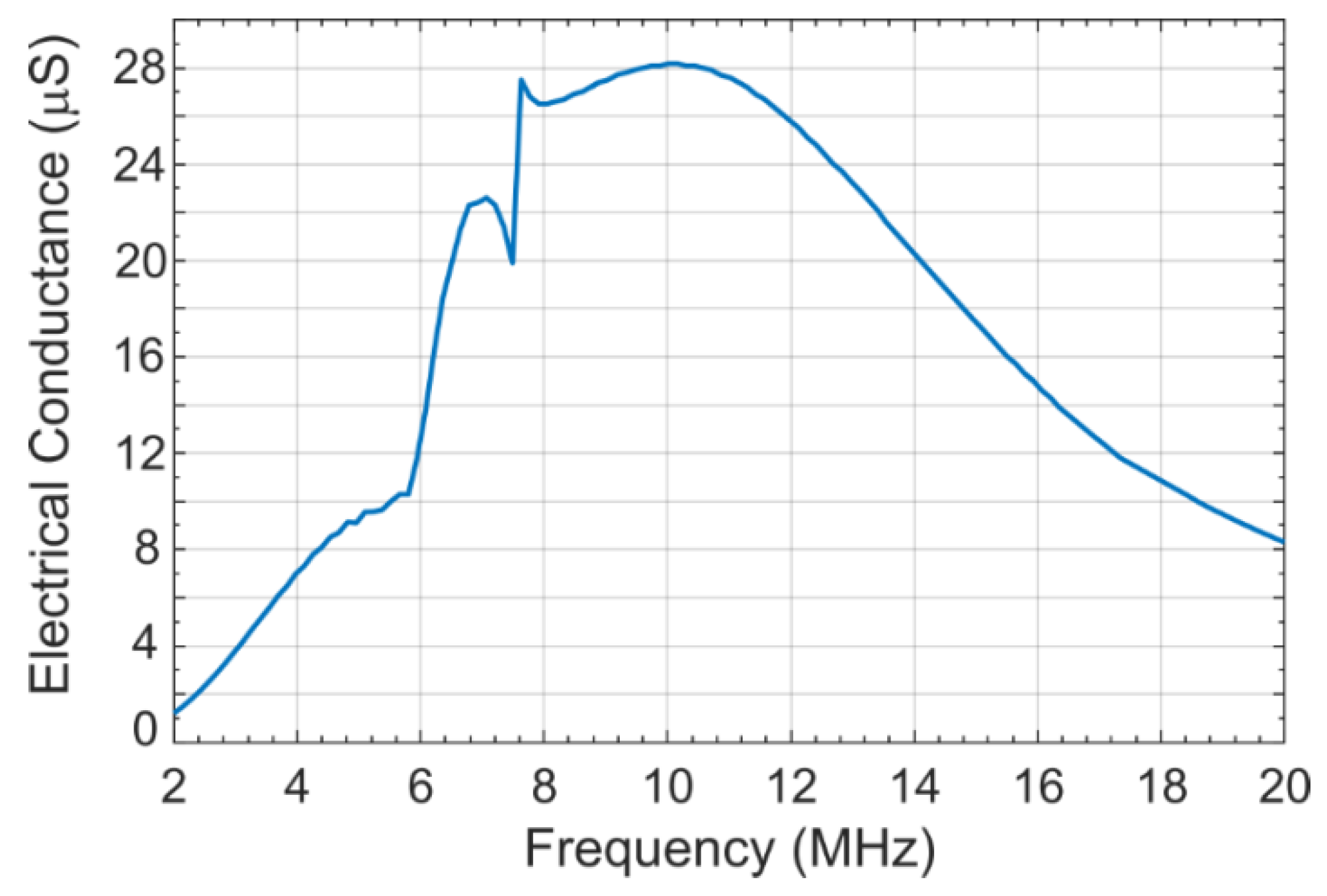An Investigation of Silica Aerogel to Reduce Acoustic Crosstalk in CMUT Arrays
Abstract
1. Introduction
2. Materials and Methods
2.1. Scientific Rationale for Using Silica Aerogel
2.2. Simulation Model Description
2.3. Acoustic Crosstalk Levels without Silica Aerogel
2.4. Acoustic Crosstalk Levels with Silica Aerogel
2.4.1. Aerogel Passivation Layer Thickness Determination
2.4.2. Effect of Aerogel Layer on Diaphragm Deflection
2.4.3. CMUT Arrays with Silica Aerogel Passivation Layer
3. Results
Experimental Validation of the Simulation Results of the Efficacy of Silica Aerogel in Crosstalk Reduction
4. Conclusions
Author Contributions
Funding
Institutional Review Board Statement
Informed Consent Statement
Data Availability Statement
Acknowledgments
Conflicts of Interest
References
- Brenner, K.; Ergun, A.; Firouzi, K.; Rasmussen, M.; Stedman, Q.; Khuri–Yakub, B. Advances in Capacitive Micromachined Ultrasonic Transducers. Micromachines 2019, 10, 152. [Google Scholar] [CrossRef]
- Klemm, M. Acoustic Simulation and Characterization of Capacitive Micromachined Ultrasonic Transducers. Master’s Thesis, Technical University of Dresden, Dresden, Germany, 2017. [Google Scholar]
- Matrone, G.; Savoia, A.; Terenzi, M.; Caliano, G.; Quaglia, F.; Magenes, G. A Volumetric CMUT-Based Ultrasound Imaging System Simulator with Integrated Reception and μ-Beamforming Electronics Models. IEEE Trans. Ultrason. Ferroelectr. Freq. Control 2014, 61, 792–804. [Google Scholar] [CrossRef]
- Zhang, X. Capacitive Micromachined Ultrasonic Transducers (CMUTs) on Glass Substrates for Next-Generation Medical Imaging and Beyond. Ph.D. Thesis, North Carolina State University, Raleigh, NC, USA, 2017. [Google Scholar]
- Bayram, B.; Kupnik, M.; Yaralioglu, G.; Oralkan, Ö.; Ergun, A.; Lin, D.; Wong, S.; Khuri-Yakub, B. Finite element modeling and experimental characterization of crosstalk in 1-D CMUT arrays. IEEE Trans. Ultrason. Ferroelectr. Freq. Control 2007, 54, 418–429. [Google Scholar] [CrossRef]
- Munir, J.; Ain, Q.; Lee, H. Reliability issue related to dielectric charging in capacitive micromachined ultrasonic transducers: A review. Microelectron. Reliab. 2019, 92, 155–167. [Google Scholar] [CrossRef]
- Bayram, B.; Yaralioglu, G.; Kupnik, M.; Khuri-Yakub, B. Acoustic Crosstalk Reduction Method for CMUT Arrays. In Proceedings of the IEEE Ultrasonic Symposium, Vancouver, BC, Canada, 3–6 October 2006; pp. 500–593. [Google Scholar]
- Ilkhechi, A.; Ceroici, C.; Li, Z.; Zemp, R. Transparent capacitive micromachined ultrasonic transducer (CMUT) arrays for real-time photoacoustic applications. Opt. Express 2020, 28, 13750–13760. [Google Scholar] [CrossRef]
- Lin, D. Interface Engineering of Capacitive Micromachined Ultrasonic Transducers for Medical Applications. Ph.D. Thesis, Stanford University, Stanford, CA, USA, 2011. [Google Scholar]
- Campbell, E.; Davis, L.; Hayward, G.; Hutchins, D. Cross-coupling in Sealed CMUT arrays for Immersion Applications. In Proceedings of the IEEE Ultrasonic Symposium, New York, NY, USA, 28–31 October 2007; pp. 2135–2138. [Google Scholar]
- Hochman, M. Investigation of Acoustic Crosstalk Effects in CMUT Arrays. Master’s Thesis, Georgia Institute of Technology, Atlanta, GA, USA, 2011. [Google Scholar]
- Nazarchuk, Z.; Skalskyi, V.; Serhiyenko, O. Acoustic Emissions: Methodology and Application; Springer: Berlin, Germany, 2017; pp. 41–42. [Google Scholar]
- Eccardt, P.; Lohfink, A.; Garssen, H. Analysis of crosstalk between fluid coupled CMUT membranes. In Proceedings of the IEEE Ultrasonic Symposium, Rotterdam, The Netherlands, 18–21 September 2005; pp. 593–596. [Google Scholar]
- Berg, S. Capacitive Micromachined Ultrasonic Transducers-Acoustic Challenges and Proposed Solutions. Ph.D. Thesis, Norwegian University of Science and Technology, Trondheim, Norway, 2012. [Google Scholar]
- Zhou, S.; Hossack, J. Reducing Inter-Element Acoustic crosstalk in capacitive Micromachined Ultrasound transducers. IEEE Trans. Ultrason. Ferroelectr. Freq. Control 2007, 54, 1217–1228. [Google Scholar] [CrossRef] [PubMed]
- Christiansen, T.; Jensen, J.; Thomsen, E. Acoustical cross-talk in row-column addressed 2-D transducer arrays for ultrasound imaging. Ultrasonics 2015, 63, 174–178. [Google Scholar] [CrossRef][Green Version]
- Engholm, M. Capacitive Micromachined Ultrasonic Transducers for 3-D Imaging. Ph.D. Thesis, Technical University of Denmark, Kongens Lyngby, Denmark, 2018. [Google Scholar]
- Arkan, E.; Degertekin, F. Analysis and Design of High-Frequency 1-D CMUT Imaging Arrays in Noncollapsed Mode. IEEE Trans. Ultrason. Ferroelectr. Freq. Control 2019, 66, 382–393. [Google Scholar] [CrossRef]
- Pirouz, A.; Degertekin, F. An Analysis Method for Capacitive Micromachined Ultrasound Transducer (CMUT) Energy Conversion during Large Signal Operation. Sensors 2019, 19, 876. [Google Scholar] [CrossRef] [PubMed]
- Haldorsen, J.; Johnson, D.; Plona, T.; Sinha, B.; Valero, H.; Winkler, K. Borehole Acoustic Waves. Oilfield Rev. 2006, 18, 34–43. [Google Scholar]
- Yashvanth, V. CMUT Crosstalk Reduction Using Crosslinked Silica Aerogel. Master’s Thesis, University of Windsor, Windsor, ON, Canada, 2018. [Google Scholar]
- Gross, J.; Reichenauer, G.; Fricke, J. Mechanical Properties of SiO2 Aerogels. J. Phys. D. Appl. Phys. 1988, 21, 1447–1451. [Google Scholar] [CrossRef]
- Aerogels. Available online: http://www.aerogel.org (accessed on 10 August 2020).
- Gurav, J.; Jung, I.; Park, H.; Kang, E.; Nadargi, D. Silica Aerogel: Synthesis and Applications. J. Nanomater. 2010, 1–12. Available online: https://www.hindawi.com/journals/jnm/2010/409310/ (accessed on 5 December 2020). [CrossRef]
- COMSOL Multiphysics General Information. Available online: https://www.comsol.com/ (accessed on 10 August 2020).
- Forest, L.; Gibiata, V.; Woignier, T. Biot’s theory of acoustic propagation in porous media applied to aerogels and alcogels. J. Non-Cryst. Solids 1998, 225, 287–292. [Google Scholar] [CrossRef]
- Aegerter, M.; Leventis, N.; Koebel, M. Aerogels Handbook (Advances in Sol.-Gel Derived Materials and Technologies); Springer: New York, NY, USA, 2011. [Google Scholar]
- Jichao, W.; Jun, S.; Xingyuan, N.; Wang, B.; Wang, X.; Jia, L. Acoustic Properties of Nanoporous Silica Aerogel. Rare Met. Mater. Eng. 2010, 39, 14–17. [Google Scholar]
- Conroy, J.; Hosticka, B.; Davis, S.; Norris, P. Evaluation of the Acoustic Properties of Silica Aerogel. In Symposium, Porous, Cellular and Microcellular Materials; ASME-Publications: New York, NY, USA, 1998; pp. 25–34. [Google Scholar]
- Pierre, A.; Rigacci, A. SiO2 Aerogel. In Aerogels Handbook; Agerter, M., Koebel, M., Leventis, N., Eds.; Springer: New York, NY, USA, 2011; pp. 21–46. [Google Scholar]
- JMurillo, S.R.; Bachlechner, M.E.; Campo, F.A.; Barbero, E.J. Structure and mechanical properties of silica aerogels and xerogels modeled by molecular dynamics simulation. J. Non-Cryst. Solids 2010, 356, 1325–1331. [Google Scholar]
- Senturia, S. Microsystems Design; Kluwer Academic Publisher: Norwell, MA, USA, 2000. [Google Scholar]
- Dooyoung, H. All-polymer ultrasonic transducer design for an intravascular ultrasonography application. Turk. J. Electr. Eng. Comput. Sci. 2019, 27, 2443–2455. Available online: https://journals.tubitak.gov.tr/elektrik/index.htm/ (accessed on 10 August 2020). [CrossRef]
- Maynard, R. Elastic and thermal properties of hierarchical structures: Application to silica aerogel. Phys. A Stat. Mech. Its Appl. 1989, 157, 601–609. [Google Scholar] [CrossRef]
- Gómez Álvarez-Arenas, T.; Montero de Espinosa, F.; Moner-Girona, M.; Rodríguez, E.; Roig, A.; Molins, E. Viscoelasticity of silica aerogels at ultrasonic frequencies. Appl. Phys. Lett. 2002, 81, 1198–1200. [Google Scholar] [CrossRef]
- Schaefer, D. What Factors Control the Structure of Silica Aerogels? J. Phys. Colloq. 1989, 50, C4-121–C4-126. [Google Scholar] [CrossRef][Green Version]
- Garrett, S. Understanding Acoustics an Experimentalist’s View of Sound and Vibration, 2nd ed.; Springer: New York, NY, USA, 2020; pp. 673–697. [Google Scholar]
- Cha, Y.; Kim, C.; Lee, S.; Hwang, H.; Moon, J.; Han, I.; Woo, S. Synthesis of silica aerogel thin film from waterglass. Solid State Phenom. 2007, 126, 671–674. [Google Scholar] [CrossRef]
- Meador, M.; Fabrizio, E.; Ilhan, F.; Dass, A.; Zhang, G.; Vassilaras, P.; Johnston, J.; Leventis, N. Cross-linking Amine-Modified Silica Aerogels with Epoxies: Mechanically Strong Lightweight Porous Materials. Chem. Mater. 2005, 17, 1085–1098. [Google Scholar] [CrossRef]
- Yang, E. Fabrication and Preliminary Characterization of Hydrophobic Silica Aerogel Films for Oil Remediation Studies. Bachelor’s Thesis, Pomona College, Claremont, CA, USA, 2011. [Google Scholar]
- IntelliISuite Product Overview. Available online: http://www.intellisense.com/ (accessed on 10 August 2020).
- Bonded, I.; Jonathan, M.; Williams, J.; Kirk, K. A high-frequency linear ultrasonic array. Development 2011, 58, 2202–2212. [Google Scholar]
- Yang, H.; Cannata, J.; Williams, J.K.; Shung, K. Crosstalk Reduction for High-Frequency Linear Array Ultrasound Transducers Using 1-3 Piezocomposites with Pseudo-Random Pillars. IEEE Trans. Ultrason. Ferroelectr. Freq. Control 2012, 40, 1301–1315. [Google Scholar] [CrossRef]
- Light, E.; Angle, J.; Smith, S. Real-time 3D ultrasound guidance of interventional devices. IEEE Trans. Ultrason. Ferroelectr Freq. Control. 2009, 292, 342–351. [Google Scholar]
- Manwar, R.; Simpson, T.; Bakhtazad, A.; Chowdhury, S. Fabrication and characterization of a high frequency and high coupling coefficient CMUT array. Microsyst. Technol. 2017, 23, 4965–4977. [Google Scholar] [CrossRef]
- Bakhtazad, A.; Chowdhury, S. An evaluation of optical profilometry techniques for CMUT characterization. Microsyst. Technol. 2019, 25, 3627–3642. [Google Scholar] [CrossRef]











| Parameter | Value | Unit |
|---|---|---|
| Cell sidelength, | 16 | µm |
| Diaphragm thickness, | 1.3 | µm |
| Gap thickness, | 650 | nm |
| Insulating layer thickness, | 100 | nm |
| Top electrode thickness, | 100 | nm |
| Contact pad thickness, | 0.4 | µm |
| Dielectric post thickness, | 2 | µm |
| Parameter | Benzocyclobutene (BCB) (Diaphragm, Dielectric Post) | Gold (Top Electrode) | Silicon (Substrate)<100> | Unit |
|---|---|---|---|---|
| Density, | 1050 | 19300 | 2329 | kg/m3 |
| 2.9 | 70 | 165 | GPa | |
| 0.34 | 0.44 | 0.26 | ||
| 28 | 106 | 55 | MPa | |
| 2.6 | 6.9 | 11.8 |
| Element Number | Peak Crosstalk Level (dB) | Average Crosstalk Level (dB) |
|---|---|---|
| 1st neighbor | −17.18 | −22.44 |
| 2nd neighbor | −21.07 | −27.46 |
| Parameter | Value | Unit |
|---|---|---|
| 0.4 | g/cm3 | |
| 50 | MPa | |
| 0.34 | ||
| 300 | m/s |
| Element Number | Peak Crosstalk Level (dB) | Average Crosstalk Level (dB) |
|---|---|---|
| 1st neighbor | –22.6 | –27.4 |
| 2nd neighbor | −28.6 | −33.8 |
| Parameter | Presented Design First Neighbor | Ref. [5] | ||
|---|---|---|---|---|
| Type | CMUT without aerogel (simulated) | CMUT with aerogel (simulated) | CMUT without Polydimethylsiloxane (PDMS) (experimental) | CMUT with 5 µm PDMS (experimental) |
| Diaphragm material | BCB | BCB | Silicon Nitride | Silicon Nitride |
| Center frequency (MHz) | 7.5 | 7.5 | 5.8 | 5.8 |
| Number of elements | 64 | 64 | 64 | 64 |
| −6 dB Fractional bandwidth | 133 | 114 | 130 | 100 |
| Peak crosstalk level (dB) | −17.18 | −22.6 | −17 | −17 |
| Average crosstalk level (dB) | −22.44 | −27.4 | −23.2 | −23.3 |
| Element Position | Average Crosstalk Level (dB) | ||
|---|---|---|---|
| Transducer type | CMUT without aerogel layer (7.5 MHz) | CMUT with aerogel layer (7.5 MHz) | Lead zirconate titanate (PZT) transducers (1–10 MHz) |
| 1st neighbor | –22.44 | −27.4 | −30 |
| 2nd neighbor | −27.46 | −33.8 | −38 |
Publisher’s Note: MDPI stays neutral with regard to jurisdictional claims in published maps and institutional affiliations. |
© 2021 by the authors. Licensee MDPI, Basel, Switzerland. This article is an open access article distributed under the terms and conditions of the Creative Commons Attribution (CC BY) license (http://creativecommons.org/licenses/by/4.0/).
Share and Cite
Yashvanth, V.; Chowdhury, S. An Investigation of Silica Aerogel to Reduce Acoustic Crosstalk in CMUT Arrays. Sensors 2021, 21, 1459. https://doi.org/10.3390/s21041459
Yashvanth V, Chowdhury S. An Investigation of Silica Aerogel to Reduce Acoustic Crosstalk in CMUT Arrays. Sensors. 2021; 21(4):1459. https://doi.org/10.3390/s21041459
Chicago/Turabian StyleYashvanth, Varshitha, and Sazzadur Chowdhury. 2021. "An Investigation of Silica Aerogel to Reduce Acoustic Crosstalk in CMUT Arrays" Sensors 21, no. 4: 1459. https://doi.org/10.3390/s21041459
APA StyleYashvanth, V., & Chowdhury, S. (2021). An Investigation of Silica Aerogel to Reduce Acoustic Crosstalk in CMUT Arrays. Sensors, 21(4), 1459. https://doi.org/10.3390/s21041459





